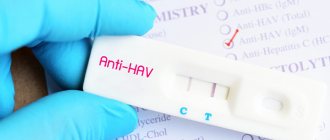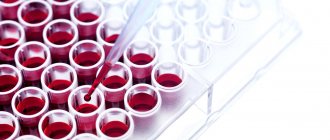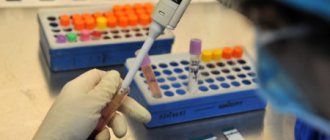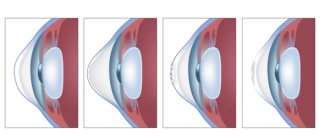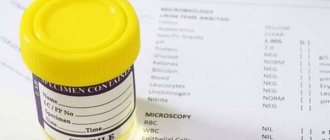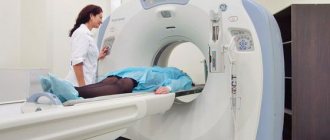Home » Medicine
Reading time: 3 minutes.
A test for antibodies to measles is a test that is performed on children who are at risk of contracting measles, pregnant women to find out about the existing risk to the fetus, and adults if there is a risk of infection. The increased interest of doctors in the results of such diagnostics is due to the danger of measles.
Antibodies to measles - what does it mean?
Measles is an acute infectious disease with a very high probability of infection through contact with a carrier of the virus. The increased susceptibility of people to the measles virus is compensated by continued lifelong immunity after illness or vaccination. Antibodies to the measles virus are responsible for specific immunity.
The production of antibodies to measles occurs:
- in the acute course of the disease;
- after vaccination;
- after a “hidden” measles infection, when a person became ill without others noticing.
How are antibodies produced in the human body?
Antibodies are special proteins that bind antigens—substances foreign to the body. During illness, antigens enter the body naturally; during vaccination, they are administered as part of the vaccine. In the body, the production of antibodies to infection is carried out by B-lymphocytes and they are stored in the membrane of these lymphocytes or blood plasma, and the main task of antibodies is immunity to the disease. For some diseases, for example, measles, lifelong protection is developed; for others, for example, influenza, permanent immunity is not developed.
Depending on the pathogen, antibodies are produced either immediately after infection or after an incubation period. There are currently five known classes of antibodies:
- IgG
- the presence of such antibodies indicates the development of stable immunity, but their presence does not indicate a specific pathogen; these antibodies are produced 2-3 weeks after the onset of the disease and can persist for life. - IgE
– the presence of these antibodies indicates the presence of a parasite in the body and allergic reactions (rhinitis, swelling, rashes). - IgA
- these antibodies are produced during respiratory infections and during infectious and non-infectious liver lesions, they begin to be detected in the blood 1-2 weeks after infection and cease to be detected after 2-3 months; constant presence in the blood indicates a chronic disease. - IgM
- the presence of these antibodies indicates the presence of an infection in the body or that the person has recently been ill. - IgD
is a poorly studied class of antibodies and is not used in diagnostics.
Symptoms and signs of measles, nature of the rash
The average incubation period is 1-2 weeks. After this, the viral element penetrates into the blood and spreads to organs and tissues.
This disease begins with the following set of symptoms:
- lethargy, increased fatigue;
- pain in the head, loss of appetite;
- runny nose, accompanied by copious discharge of mucus, which may contain pus;
- dry cough reflex;
- hoarseness of voice;
- eye lesions (conjunctivitis);
- increased body temperature, fever.
On days 3-5 of the disease, the patient may feel that his health has improved slightly. At this stage, the temperature decreases. But after a couple of days everything returns to normal. Moreover, the symptomatic picture is aggravated by additional phenomena in the form of spots that resemble accumulated semolina grains. The rash consists of several blisters surrounded by spots. The sores are small in size, but there are many of them and they are bright. The rash covers the entire surface of the body and can lead to hemorrhages.
Sores that form during the progression of this disease have a certain sequence of development.
- On the first day of the disease, they are localized behind the ears, in the scalp, and appear on the neck and face.
- On the second day they affect the body and upper arms.
- At the next stage, they fall on the lower limbs and the remaining parts of the arms, which were not previously affected. The rashes on the face become paler.
- On the 4th day of the disease, the sores become pale in the same sequence in which they appeared. They leave behind severe peeling and darkening of the skin.
If you do not make timely attempts to treat this disease, there is a possibility of complications:
- inflammation of the larynx (laryngitis);
- croup;
- otitis;
- pneumonia;
- measles encephalitis;
- meningitis.
Timely detection of primary symptoms and subsequent diagnosis will allow us to eradicate the disease in the early stages.
When is a measles antibody test needed?
Testing for antibodies to measles is often necessary for pregnant women who do not have information about whether they have had this infection or not, whether they have been vaccinated, and there is a risk of infection. For pregnant women, measles has serious consequences:
In some cases (at the discretion of the doctor), a test for antibodies to measles is done even after an illness or vaccination; this is necessary because:
- a small number of people (about 10%) do not develop immunity after vaccination;
- 20-30% of people lose measles immune globulin due to treatment with immunosuppressants, antibiotics, or other reasons.
Laboratory confirmation of infection
To make sure that the patient is suffering from measles and not from some other ailment, it is necessary to conduct an enzyme immunoassay for the virus. It is a laboratory study that includes the determination of special biochemical reactions. With their help, it becomes possible to detect the amount of immunoglobulins in the blood, i.e. antibodies - proteins produced by blood cells.
Formation of immunoglobulins in response to virus penetration
When pathogens of certain infections enter the human body, immunoglobulins gradually bind to them, which then neutralize them. There are as many different microbes, toxins, viruses as there are immunoglobulins. Together with the blood, they are able to penetrate even the farthest corners of the body and overtake aggressor pathogens.
To diagnose measles, specialists most often use the following complex and examinations:
- general blood test (CBC), which allows you to track changes in its structure and composition;
- enzyme immunoassay for antibodies (it stands for ELISA).
In order for the diagnostic process to lead to the desired result - an accurate identification of the pathogen, it must be carried out correctly.
Determination of antibodies to measles
You need to donate blood for measles antibodies if
- it is not known whether the vaccination was given;
- it is necessary to confirm the diagnosis;
- there was contact with a possible sick person;
- during an epidemiological survey.
Measles in the acute period manifests itself very clearly:
- heat;
- measles rash (spots more than 1 cm in diameter with a papule in the center);
- breathing problems;
- conjunctivitis;
- photophobia;
- swelling of the eyelids;
- cough and runny nose.
Definition
Antibodies to measles (the norm in adults is monitored less frequently than in childhood) are proteins in nature. They bind to measles viruses, which are antigens - foreign or potentially dangerous substances to the body.
If a person gets sick, the infectious agent enters the body through the mucous membranes of the respiratory tract. Antigens can also enter the body after vaccination, since they are part of vaccination preparations.
Measles is an acute viral disease. The infection is characterized by a high degree of contagiousness, but if a person has had it, then immunity to it usually remains for life and re-infection is rare and, as a rule, in people with various immunodeficiencies. After vaccination against measles, it persists for several years, which is why doctors recommend revaccination every 10 years.
Antibody test for measles - explanation
A test for antibodies to the measles virus, the decoding of which takes up to 48 hours, is carried out in a medical institution.
To decipher the result, consider antibodies of the IgG and IgM classes:
- both indicators are negative – there is no immunity to measles, there is no infection in the blood;
- both indicators are positive - measles has entered the final stage, immunity has been developed;
- IgG – positive, IgM – negative – there is immunity, no measles;
- IgG – negative, IgM – positive – there is no immunity, measles is in the very initial stage.
Antibodies to measles are normal
The interpretation of the analysis is based on the titer of antibodies to measles, which can be:
- less than 0.12 – in this case the result is negative;
- in the range from 0.12 to 0.18 - this result is considered doubtful, it is recommended to retake the analysis after 7-14 days;
- more than 0.18 – positive indicators of antibodies to measles.
Antibodies to measles virus IgG
IgG antibodies to measles present in the blood indicate a previous illness or the presence of an infection in the blood in the present time, and also show the strength of the immune system against the measles virus. The presence of antibodies after vaccination indicates that immunity has been successfully developed. With the disease, IgG antibodies appear approximately 3 weeks after infection, 2 days before the rash appears.
Repeated vaccination against measles (when immunity to the disease wanes) leads to a rapid increase in IgG antibodies, which protect the body from a dangerous disease. Infants up to 6-7 months have a high level of IgG antibodies - these are maternal anti-measles antibodies that protect the child in the first months of life, but then this immunity acquired from the mother fades away.
IgM antibodies to measles virus
IgM antibodies to the measles virus present in the blood indicate the initial stage of the disease and the need for urgent medical care to prevent complications and infection of others. After suffering from measles, IgM antibodies remain in the blood for several months - this indicator can be used to understand that a person has recently suffered from a dangerous disease.
A serious viral disease such as measles is a dangerous disease that can lead to death if a child becomes infected at an early age.
Mothers who give birth, who are immune to the highly contagious virus, pass on measles antibodies to their babies. This process of antibody transfer provides newborns with protection from the virus during the first 6–7 months of life. In the next six months, the risk of contracting the virus is increasing.
For this reason, infants and older children all over the world are vaccinated against measles. However, such vaccination guarantees stable immunity to the disease not for life, but for several years. Immunity to measles is developed for life only after an illness.
How to pass correctly
The essence of the study is to determine the patient’s health status and diagnose the disease. To do this, the laboratory assistant takes a small amount of blood serum and antigen and sends it all to the surface of a special tablet. An antibody and an antigen belonging to the same species combine with each other “like a key and a lock,” forming a single immune complex. Subsequently, a substance is added that colors it. Based on the intensity of the resulting color, the concentration of these immunoglobulins in the serum is determined.
The advantage of the ELISA method is that it assumes high sensitivity even to low levels of immunoglobulins and has specificity. This can only speak of the high accuracy and reliability of the results obtained. Typically, the study lasts 1-2 days, and some laboratories are ready to provide urgent results a few hours after the examination for an additional fee.
General information about the disease
The causative agent of an acute infectious disease is paramycovirus. The carrier of the infection is a patient with measles, who poses a danger of infecting others from the last two days of the incubation period until the fourth day preceding the rash. From the day the rash appears, the patient is no longer contagious and has immunity.
The mode of transmission of measles is airborne infection. Large amounts of infection are released when coughing or sneezing. The time from the moment of infection to the appearance of the first signs of the disease is 9–17 days.
If you have the slightest suspicion that you have been infected with this disease, you must immediately take the tests necessary to diagnose the virus, and then carry out treatment.
Measles virus, IgG antibodies
Measles virus, IgG antibodies
Measles is a highly contagious anthroponotic acute infectious disease, occurring mainly in children, and is characterized by fever, catarrhal inflammation of the mucous membranes of the nose, eyes and throat and the appearance of rash spots on the skin.
Etiology. The causative agent of measles is an RNA-containing virus Polinozamorbillarum of the paramyxoviridae family, which also includes infectious mumps viruses, canine distemper and rinderpest. The measles virus is quickly inactivated by heat, ultraviolet irradiation, and under the influence of disinfectants
Epidemiology. Measles is widespread. The source of infection is only a sick person who releases the measles virus into the external environment from the last 2 days of the incubation period until the 4th day after the rash. The route of transmission of the measles virus is airborne, but contact transmission of the infection should also be taken into account. Natural susceptibility to measles can be considered universal, with the exception of children in the first 3 months of life with innate immunity received from a mother who has had measles or has been vaccinated. Measles is extremely contagious, with susceptibility approaching 100%. After the illness, lifelong immunity remains; cases of recurrent illness are extremely rare.
Pathogenesis. The entry point of infection is the mucous membrane of the upper respiratory tract. The virus multiplies in the epithelium of the respiratory tract, as well as in other epithelial cells. Next, the virus enters the lymph nodes through the bloodstream (primary viremia, which develops already in the incubation period). After multiplying in the lymph nodes, the virus enters the blood again, and repeated (secondary) viremia develops, which is associated with the onset of clinical manifestations of the disease. The virus mainly affects the upper respiratory tract, less often the bronchi and lungs, the conjunctiva, and to a small extent the gastrointestinal tract. In some cases, the virus can be introduced into the brain, causing the development of specific measles encephalitis.
Clinical manifestations. The incubation period is 9-17 days, with gamma globulin prophylaxis - up to 21 days. A staged development is observed. In the catarrhal period, the temperature rises (38-39 ° C), headache, cough, runny nose, malaise, tearfulness, and sleep disturbance occur; symptoms last up to 3 days (rarely - up to 6), then photophobia, chesty, hoarse cough develop; the face, eyelids, lips, nasal concha swell; 1-2 days before the rash, Belsky-Filatov-Koplik spots appear (small poppy white-gray spots with a narrow border of hyperemia, separated and not removable on the nasal mucosa, conjunctiva, gums, genital mucosa) and last from several hours to 3 days . This is a pathognomonic sign. In addition, measles enanthema is observed on the mucous membranes - an analogue of a rash on the skin. During the period of rashes on the first day, the temperature is higher than during the catarrhal period, and remains elevated throughout the entire period of rashes; the rash is macular and nodular on an unchanged background, merging in places; leaves pigmentation and scaly peeling; Petechial and hemorrhagic rashes are possible. During the pigmentation period, after the rash disappears, pigmentation and pityriasis-like peeling remain. Pigmentation lasts 1-1.5 weeks, sometimes more. The body temperature is normalized, the general condition is restored.
Measles is rare in pregnant women and can lead to premature birth, spontaneous abortion, and stillbirth. Newborn children of mothers who have immunity against measles are protected from infection by maternal antibodies, up to 6-7 months of age after birth. Starting from the second half of life, children’s susceptibility to the disease increases.
Laboratory diagnosis of measles. Serological diagnostic methods are used to confirm the diagnosis, especially of erased, atypical forms of measles.
Measles virus, IgM antibodies. IgM antibodies to the measles virus can be detected in the acute period of the disease, starting 3 days after the onset of the rash, reach a peak after 2-3 weeks, last for 4 weeks and gradually decrease (50% of patients become seronegative after 4 months).
Measles virus, IgG antibodies. IgG antibodies to the measles virus appear after IgM antibodies, approximately 2 weeks after infection. Blood is taken for testing on days 4-7 from the moment the rash appears (1st serum) and no earlier than 10-14 days from the date of the first sample (2nd serum). An increase in IgG antibody titer in paired sera by more than 4 times indicates a current infection. IgG antibodies persist after illness, usually for life. IgG against the measles virus is also detected after vaccination. By their presence in the blood, one can judge the presence of immunity to this disease. In the blood of newborns up to 6-7 months of age, maternal IgG antibodies obtained through the placenta from the mother’s blood during pregnancy can be detected (IgM antibodies do not pass through the placenta). Upon repeated contact with the virus, immune individuals experience a rapid increase in titers of highly specific IgG, which provides protection against infection (no clinical manifestations or virus shedding are observed).
| Index | Characteristic |
| Material | Deoxygenated blood |
| Patient preparation rules | Standard, see section No. 15 |
| Transport medium, tube | Vacutainer with/without anticoagulant with/without gel phase |
| Transportation rules and conditions, sample stability | Standard, see section No. 17 |
| Test Method | ELISA, flow cytometry |
| Analyzer and test system | EUROIMMUN Analyzer I, BioPleх 2200; EUROIMMUN AG (Germany), BioRad (USA). |
| Reference values: IgM antibodies (antibody index): R |
Measles virus, IgM antibodies
| Indications for use | |
| |
| Interpretation of results | |
| Discovered | Not detected |
|
|
| Result | Interpretation |
| IgG +, IgM - | Previous infection (no risk to the fetus) |
| IgG+, IgM+ | Infection within the last 7-120 days (possible risk to the fetus) |
| IgG - , IgM + | Acute infection (maximum risk to the fetus) |
| IgG - , IgM - | The mother does not have specific immunity - there is a risk of infection. There are no signs of acute infection. It is necessary to repeat the serological test after 3 weeks. In this case, the appearance of IgM indicates an acute infection |
2164
Measles is a highly contagious anthroponotic acute infectious disease, occurring mainly in children, and is characterized by fever, catarrhal inflammation of the mucous membranes of the nose, eyes and throat and the appearance of rash spots on the skin.
Etiology. The causative agent of measles is an RNA-containing virus Polinozamorbillarum of the paramyxoviridae family, which also includes infectious mumps viruses, canine distemper and rinderpest. The measles virus is quickly inactivated by heat, ultraviolet irradiation, and under the influence of disinfectants
Epidemiology. Measles is widespread. The source of infection is only a sick person who releases the measles virus into the external environment from the last 2 days of the incubation period until the 4th day after the rash. The route of transmission of the measles virus is airborne, but contact transmission of the infection should also be taken into account. Natural susceptibility to measles can be considered universal, with the exception of children in the first 3 months of life with innate immunity received from a mother who has had measles or has been vaccinated. Measles is extremely contagious, with susceptibility approaching 100%. After the illness, lifelong immunity remains; cases of recurrent illness are extremely rare.
Pathogenesis. The entry point of infection is the mucous membrane of the upper respiratory tract. The virus multiplies in the epithelium of the respiratory tract, as well as in other epithelial cells. Next, the virus enters the lymph nodes through the bloodstream (primary viremia, which develops already in the incubation period). After multiplying in the lymph nodes, the virus enters the blood again, and repeated (secondary) viremia develops, which is associated with the onset of clinical manifestations of the disease. The virus mainly affects the upper respiratory tract, less often the bronchi and lungs, the conjunctiva, and to a small extent the gastrointestinal tract. In some cases, the virus can be introduced into the brain, causing the development of specific measles encephalitis.
Clinical manifestations. The incubation period is 9-17 days, with gamma globulin prophylaxis - up to 21 days. A staged development is observed. In the catarrhal period, the temperature rises (38-39 ° C), headache, cough, runny nose, malaise, tearfulness, and sleep disturbance occur; symptoms last up to 3 days (rarely - up to 6), then photophobia, chesty, hoarse cough develop; the face, eyelids, lips, nasal concha swell; 1-2 days before the rash, Belsky-Filatov-Koplik spots appear (small poppy white-gray spots with a narrow border of hyperemia, separated and not removable on the nasal mucosa, conjunctiva, gums, genital mucosa) and last from several hours to 3 days . This is a pathognomonic sign. In addition, measles enanthema is observed on the mucous membranes - an analogue of a rash on the skin. During the period of rashes on the first day, the temperature is higher than during the catarrhal period, and remains elevated throughout the entire period of rashes; the rash is macular and nodular on an unchanged background, merging in places; leaves pigmentation and scaly peeling; Petechial and hemorrhagic rashes are possible. During the pigmentation period, after the rash disappears, pigmentation and pityriasis-like peeling remain. Pigmentation lasts 1-1.5 weeks, sometimes more. The body temperature is normalized, the general condition is restored.
Measles is rare in pregnant women and can lead to premature birth, spontaneous abortion, and stillbirth. Newborn children of mothers who have immunity against measles are protected from infection by maternal antibodies, up to 6-7 months of age after birth. Starting from the second half of life, children’s susceptibility to the disease increases.
Laboratory diagnosis of measles. Serological diagnostic methods are used to confirm the diagnosis, especially of erased, atypical forms of measles.
Measles virus, IgM antibodies. IgM antibodies to the measles virus can be detected in the acute period of the disease, starting 3 days after the onset of the rash, reach a peak after 2-3 weeks, last for 4 weeks and gradually decrease (50% of patients become seronegative after 4 months).
Measles virus, IgG antibodies. IgG antibodies to the measles virus appear after IgM antibodies, approximately 2 weeks after infection. Blood is taken for testing on days 4-7 from the moment the rash appears (1st serum) and no earlier than 10-14 days from the date of the first sample (2nd serum). An increase in IgG antibody titer in paired sera by more than 4 times indicates a current infection. IgG antibodies persist after illness, usually for life. IgG against the measles virus is also detected after vaccination. By their presence in the blood, one can judge the presence of immunity to this disease. In the blood of newborns up to 6-7 months of age, maternal IgG antibodies obtained through the placenta from the mother’s blood during pregnancy can be detected (IgM antibodies do not pass through the placenta). Upon repeated contact with the virus, immune individuals experience a rapid increase in titers of highly specific IgG, which provides protection against infection (no clinical manifestations or virus shedding are observed).
| Index | Characteristic |
| Material | Deoxygenated blood |
| Patient preparation rules | Standard, see section No. 15 |
| Transport medium, tube | Vacutainer with/without anticoagulant with/without gel phase |
| Transportation rules and conditions, sample stability | Standard, see section No. 17 |
| Test Method | ELISA, flow cytometry |
| Analyzer and test system | EUROIMMUN Analyzer I, BioPleх 2200; EUROIMMUN AG (Germany), BioRad (USA). |
| Reference values: IgM antibodies (antibody index): R |
Measles virus, IgM antibodies
| Indications for use | |
| |
| Interpretation of results | |
| Discovered | Not detected |
|
|
| Result | Interpretation |
| IgG +, IgM - | Previous infection (no risk to the fetus) |
| IgG+, IgM+ | Infection within the last 7-120 days (possible risk to the fetus) |
| IgG - , IgM + | Acute infection (maximum risk to the fetus) |
| IgG - , IgM - | The mother does not have specific immunity - there is a risk of infection. There are no signs of acute infection. It is necessary to repeat the serological test after 3 weeks. In this case, the appearance of IgM indicates an acute infection |
How to prepare for analysis:
Blood analysis
To exclude factors that may influence the results of the study, you must adhere to the following preparation rules:
- Blood for research is donated only on an empty stomach!
- Before donating venous blood, it is advisable to rest for 15 minutes;
- 12 hours before the test, you should avoid drinking alcohol, smoking, eating, and limiting physical activity;
- Avoid taking medications. If it is not possible to stop taking the medication, the laboratory must be informed;
- Children under 5 years old, before donating blood, must be given boiled water (in portions, up to 150-200 ml, for 30 minutes)
synevolab.ru
How does the disease progress?
Diagnosis of measles occurs after probable contact with a sick person. Characteristic symptoms are high fever, rash, breathing problems and others.
The clinical picture of measles consists of several stages:
The catarrhal period is observed for the first time for 6 days.
It is characterized by the presence of the following symptoms:
- High temperature over 38° C;
- Headache;
- Runny nose;
- Dry cough;
- Hoarse voice;
- Conjunctival inflammation;
- Swelling of the eyelids.
During diagnosis, the doctor may see red spots on the palate and pinpoint whitish areas on the mucous membrane of the cheeks.
The appearance of a rash. This period lasts about 3–4 days.
The period is characterized by the appearance of:
- Temperatures over 39° C;
- Cough;
- Photophobia;
- Tearing;
- Measles rash - spots that are enlarged in diameter - more than 1 cm and have a papule in the center. Subsequently, these spots can merge and form various figures with scalloped edges;
- Pigmentation lasts for 1–1.5 weeks.
This is the final stage of the disease, which occurs on the fifth day after the onset of the second period. The spots that appeared earlier begin to fade, and in their place a brownish pigmentation appears.
Blood test for IgG
This test is performed to confirm the presence of immunity or absence of IgG antibodies.
The level of presence of IgG in the blood serum indicates the presence of:
- Measles in past or current tense;
- Strength of immunity against measles virus.
Similar tensions arise:
- After vaccination. The presence of IgG antibodies will indicate the presence of immunity to measles.
- Transmission of measles. Antibodies of this class can be detected no earlier than the third week after infection or by the second day of the rash period.
If the virus re-enters the body of immunoprotected individuals, a rapid increase in IgG in the blood occurs, which will provide protection against measles.
If you conduct a similar blood test in newborns for the first six months of life, you can detect a high level of IgG, which was transferred from mother to child through the placenta. Such anti-measles maternal antibodies, which make up the baby’s immunity, are able to protect the baby for the first 6–7 months.
When is it necessary to get tested?
Antibodies to measles (the norm in adults, as a rule, are checked in cases of possible infection or after recovery) arise as a result of vaccinations or a previous illness. Referral for analysis is carried out based on the clinical picture and the collected anamnesis.
Measles is caused by an RNA virus of the morbillivirus genus belonging to the paramyxovirus family. It has a spherical shape. Its dimensions range from 120 to 230 nm. The causative agent of measles does not lose its activity in the air and on various surfaces for up to 2 hours.
It quickly dies outside the human body under the influence of various chemical and physical factors, including during boiling and when treated with antiseptic solutions. But although measles viruses have little resistance in the environment, there have been cases when the infectious agent spread over a greater distance with the air through the ventilation system in one building during cold times.
The main route of transmission of the disease is aerosol. The measles virus is released into the environment from an infected person along with mucus when coughing and sneezing. The disease is considered one of the most contagious, and each sick person infects 9 out of 10 people who come into contact with him and do not have immunity to measles. The infection is transmitted only from person to person.
A patient with measles is contagious to people 4 days before the end of the incubation period and up to 4 days from the onset of the rash. On the 5th day from the moment the rash appears, the patient becomes non-infectious. Before the measles vaccine was developed and it began to be widely used, it was mainly children 2-5 years old who got sick; adults who had not been sick before were less likely to get infected.
When the mother has previously had a viral infection, the newborn baby develops innate or colostral immunity. This is acquired passive immunity, which develops during the transfer of immunoglobulins from mother to child during fetal development or along with colostrum.
This immunity lasts for 6-9 months of the baby’s life. And if a woman was vaccinated in childhood and did not get sick at a later age, then the baby’s passive immunity remains for less than forty years. There are also possible cases of measles transmission through the placenta from a sick mother to the fetus.
Outbreaks of the disease occur in winter and spring from December to May.
Usually the incubation period varies from 7 to 14 days (but it happens that it lasts up to 17 days) during which there are no signs of the disease.
How to prepare for a blood test
Basic requirements before blood testing:
- Delivery on an empty stomach. In the morning you are allowed to drink only plain water. The last meal should be eaten at least 8 hours before the test;
- The last meal should be light. Avoid fatty and fried foods;
- One day before the test, you should not drink alcohol;
- It is advisable to donate blood after stopping medications; if this is not possible, then at least 10–14 days after the course of medication. If this is not possible, then when taking a blood test you need to tell the laboratory assistant what kind of medicine you are taking and in what dosage.
These simple rules must be followed before a general analysis and blood donation for IgG antibodies.
Content:
Characteristic changes in the UAC
With measles, the following changes in the general blood test may occur:
- decrease in the number of monocytes, lymphocytes, neutrophils, leukocytes;
- decrease in eosinophil content;
- slight increase in ESR.
To detect these changes, you need to know not only what level of antibodies in the blood, but also normal CBC values depending on age.
What kind of analysis is this?
A study to identify specific class G antibodies to the measles virus, which are a marker of past or current infection.
What biomaterial can be used for research??
The causative agent of measles (RNA virus of the genus Morbillivirus, family of Paramyxoviruses) belongs to the family of Paramyxoviruses, which cause measles in children and adults who have not had it.
Measles (lat. Morbilli
)
- an acute infectious viral disease with a high level of susceptibility (contagiousness index approaches 100%), which is characterized by high fever (up to 40.5 ° C), inflammation of the mucous membranes of the oral cavity and upper respiratory tract, conjunctivitis and a characteristic maculopapular rash of the skin , general intoxication.
Measles remains one of the leading causes of death among young children worldwide. An estimated 158,000 people died from measles in 2011, most of them children under five years of age
Measles symptoms
The incubation period lasts on average about 1-2 weeks.
Antibodies to measles virus (Measles), (anti-Measles) IgG, quantitative determination
041001 —
Description
IgG antibodies are a marker of contact with the measles virus. IgG antibodies begin to be produced from the moment the rash appears and reach maximum levels after 2 weeks; they can be detected for many years after the infection. Measles is a highly contagious acute infectious disease with airborne transmission. The causative agent of measles is an RNA virus (family Paramyxoviridae, genus Morbillivirus). At the onset of the disease, there is an increase in body temperature to 38 ° C and above, cough, runny nose, sneezing, redness of the eyes and photophobia, enanthema in the oral cavity (Filatov-Koplik spots). From the 4th-5th day of illness, a gradual rash of maculopapular rash is observed (on the first day the rash appears on the face and neck, on the second day on the torso, on the third day on the legs and arms), pigmentation and pityriasis-like peeling remain at the site of the rash.
Purpose of the study.
- Confirmation of the diagnosis of measles in combination with the determination of IgM class antibodies
Reference values: Less than 0.13 – negative result; From 0.13 to 0.17 – borderline result (gray zone); 0.18 or more is a positive result.
Interpretation.
We draw your attention to the fact that the interpretation of research results, diagnosis, as well as the prescription of treatment, in accordance with Federal Law No. 323 “On the fundamentals of protecting the health of citizens in the Russian Federation,” must be carried out by a doctor of the appropriate specialization.
The presence of IgG antibodies indicates contact with the measles virus. To confirm the diagnosis, it is recommended to study in combination with the determination of IgM antibodies in paired sera.
* The price does not include the cost of taking biomaterial. When ordering several services at a time, the service for collecting biomaterial is paid only once.
www.cmd-online.ru
Why is analysis carried out?/Increasing and decreasing indicators
- In order to ensure the presence of measles immunity obtained as a result of previous illness or vaccination.
- To confirm the diagnosis of active or past illness, especially if there are no symptoms typical of measles.
- In order to find out what causes infectious diseases such as encephalitis, bronchitis or pneumonia - bacterial infections or complications of measles.
When is the study scheduled?
- For symptoms indicating current or past measles disease. They develop 7-18 days after infection.
- When assessing immunity to measles in people who have had the disease or have been vaccinated against it.
In what cases is research carried out?
A blood test for the corresponding immunoglobulins is done, first of all, to people who, during a comprehensive examination, were diagnosed with similar symptoms or a combination of them:
Endoscopic examination of the intestine
- Pain in the throat area.
- Tearing.
- Dry cough.
- Fever.
- Stomatitis.
- Conjunctivitis.
- Itchy rash on the surface of the skin.
- Temperature rising above 38-39° C.
- Redness of the eyes.
- Fear of light.
- Tachycardia.
- Parietal breathing.
- Exhaustion of the body.
- Angina.
- Epidermal pigmentation.
- Loss of appetite.
- Intoxication.
- Arterial hypotension (low blood pressure).
- Hyperemia.
- Sneezing.
- Swelling of the eyelids.
- Otitis.
- Reddish and whitish spots on the palate.
- Continuous headaches.
- Joint pain.
- Rhinitis (runny nose).
- Changes in voice, hoarseness.
- Encephalitis.
- Severe wheezing when breathing.
AIDS, significantly weakening the human immune system, often facilitates the unhindered penetration of the morbillovirus into the body. Children and adolescents are often asked to take a blood test to determine the strength of immunity to measles when a quarantine regime is introduced on the territory of educational institutions. Among other things, there are so-called risk factors that can also contribute to the appointment of an immunoglobulin test.
If we talk about how many of them exist at the moment, it is worth highlighting the most significant of them:
- Living in extremely unsanitary conditions.
- Visiting countries where viral disease is common.
- General decrease in the level of immunity.
People suffering from the consequences of vitamin A deficiency are also at risk: against the background of signs of vitamin deficiency (night blindness, dry skin, etc.), they may simultaneously develop symptoms of a dangerous infection. Therefore, if you have a chronic lack of retinol, you should immediately visit a doctor in order to restore the body’s protective barriers.
It should be remembered that measles in most cases affects those who have direct contact with sick people.
Results/Normal/Transcript of analysis
Result: negative.
Concentration: 0 - 0.12 IU/ml.
Positive result
A positive result in a previously seronegative patient confirms current or past disease.
If IgG antibodies to measles are detected in a patient who has previously been vaccinated and/or was not sick at the time of the test, it means that he has strong immunity that protects against infection.
Negative result
If IgG antibodies to measles are not detected in the blood, there is no immunity to the virus. The reason for this may be lack of contact with the measles virus, too early infection when IgG has not had time to be produced, or disturbances in the functioning of the immune system.
Significance
After the measles pathogen enters the mucous membranes of the respiratory tract, it begins to multiply and spreads throughout the body through the bloodstream. In response to this, the immune system begins to synthesize antibodies, which, having detected foreign agents, come into contact with them and neutralize them.
When there is initially a high content of immunoglobulins in the blood, they will quickly cleanse the body of viruses and complications will not arise. The mechanism of action of the response to microorganisms is based on a system called “lock and key”.
The immune system produces the required amount of antibodies and gives them a special structure that allows immunoglobulins, like keys, to “embed” into the corresponding holes of the virus locks and eliminate them.
Antibodies have a good memory, thanks to which once they encounter pathogenic agents, they forever remember what foreign agents look like, so when they enter the body again, immunoglobulins immediately react to the danger and eliminate the infection before it begins to develop.
And since the measles virus hardly changes, when it enters the body, antibodies begin to immediately attack it. Usually, when a pathogen enters the body for the first time, antibodies do not begin to be produced very quickly and during the immune response the risk of infection of people by aerosol increases.

